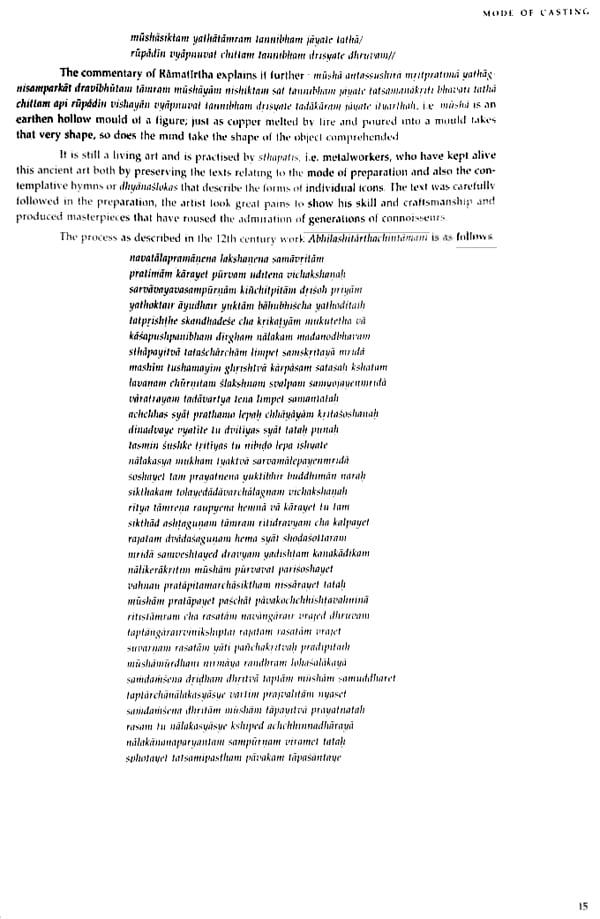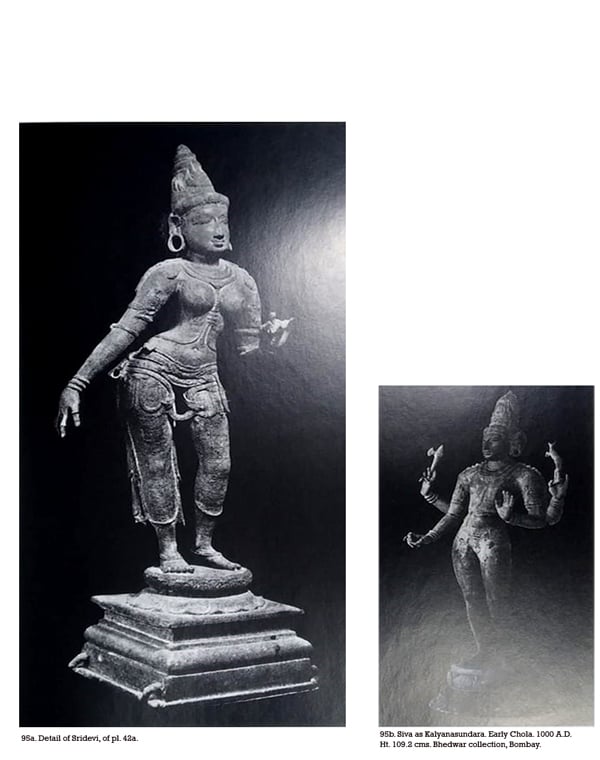
South Indian Bronzes
Book Specification
| Item Code: | NAZ812 |
| Author: | C. Sivaramamurti |
| Publisher: | Lalit Kala Akademi |
| Language: | English |
| Edition: | 2006 |
| ISBN: | 8187507233 |
| Pages: | 188 (Throughout B/w and Color Illustrations) |
| Cover: | HARDCOVER |
| Other Details | 14.00 X 11.00 inch |
| Weight | 1.88 kg |
Book Description
Much new material has come to light since the days when Coomaraswamy and Gangoly wrote their pioneering treatises. In 1933, Gravely and Ramachandran published the Catalogue of Metal Images in the Madras Government Museum. It is the first exhaustive treatment of the subject. But at that time the existence of Pallava metal images was still in doubt and separate schools in the South could not yet be fully recognized. Today, the existence of Pallava metal images and other styles in different areas in the South under different dynasties is coming to be widely recognized. In this volume an attempt has been made to indicate a broad-based classification of several styles as well as to establish a reasonably certain chronology without being dogmatic. It is hoped that this will prove useful to students of this subject for further research. Apart from the well-known masterpieces, many fine examples little known to the world at large have also been included in this publication, with a view to a better understanding of the glorious achievements of the South Indian metal sculptor in the days of the Pal lavas, the Cholas, the Pandyas and the Cheras.
I am thankful to the various museums and individuals who have helped me with illustrations for this book. I must here mention the Director-General of Archaeology in India, the National Museum, the Madras Museum, the Prince of Wales Museum, Bombay, the Royal Academy, London, the Musee Guimet, Paris, Victoria and Albert Museum, London, the Museum of Fine Arts, Boston, Rietberg Museum, Zurich, the Wm. Rockhill Nelson Gallery of Art, Kansas City, and the Metropolitan Museum of Art, New York. I am also thankful to Mr. S.T. Srinivasa Gopalachari, Mr. N.Y. Shastri, Mr. Gautam Sarabhai, and Mr. Haridas Swali for photographs of their splendid collections. For personal kindness I am grateful to Dr. S.T. Satyamurti, Superintendent, Madras Museum; Mr. S.R. Balasubramanyam; Mlle. J. Auboyer, Musee Guimet; Dr. W.G. Archer, Victoria and Albert Museum; Dr. Asch win Lippe, Metropolitan Museum of Art; Dr. Wehril, Zurich City Museum; Dr. J.E. Van Lohuizende Leeuw, Amsterdam University; Professor J. Filliozat and Mr. Pattabiramin, Institute Francais d'lndologie, Pondicherry; Mrs. Madhuri Desai and Mr. Soli Batlivala of the Bhulabhai Memorial Institute; Mr. Pramod Chandra; Mrs. Ruth Reeves; and the Collector of Tanjavur.
I do not know how to thank adequately Mr. Khandalavala, the Honorary Editor of the Lalit Kala publications who has discussed several problems with me relating to the bronzes and helped me in the selection of plates. The Assistant Editor Mrs. Helen Chandra has spared no pains to make this publication as attractive as possible. I express my grateful thanks to them both.
Asoka's vast empire extended to the limits of the Chela kingdom in the south and practically covered the whole of India, overflowing into. Kamdahar, the Kabul Valley and Baluchistan. The Sungas and Satavahanas who succeeded the Mauryas in the north and south respectively in about B.C. 200 continued the Mauryan tradition. The Satavahanas who ruled in the Deccan and the south had a long reign of about 400 years from circa 200 B.C. to A.D. 200. The early inscription at anaghat which graphically presents the glory of the early Satavahana king Satakarni, who performed several sacrifices and gave liberal gifts, speaks after the opulence of the empire and its prosperity. On the Safichi gateway is an inscription mentioning that it was fashioned by the ivory carvers after Vidisa. The fine workmanship in stone of these ivory carvers reveals the high standard of efficiency of these craftsmen. The metal images found at Buddhism, Amaravati and other places near about the eastern Andhra capital and in Kolhapur near the western capital of Pratishthana shaw the high watermark after metalwork in the Satavahana period. Cautamiputra Satakarni and Vasishthiputra Pulamavi in the first half of the 2nd century A.D. greatly fostered art, and we know that this was the best period after Satavahana art. This tradition was continued by Yajfia Satakarni, Chandra Satakarni, and other successors of these illustrious monarchs.
The Ikshvakus who. sue needed the Satavahanas towards the end of the 2nd century A.D. were also great patrons of art, and though followers of Vedic Brahmanism, were still the creators of the magnificent Buddhist monuments at Nagarjunakonda. Recent discoveries have shown that the metalwork of the Ikshvaku period in the Krishna Valley was indeed as competent as their stone carving.
The Pal lavas who ruled from Kafichi in the 4th century A.D. extended the northern boundary of their kingdom up to. the Krshna Valley. As their earlier chronology is somewhat obscure, it is with the advent of Simhavishnu that Pallava history has to be considered for our purpose.
Simhavishnu's son Mahendravarman I (A.D. 600-630) was singularly art-minded and was responsible for the introduction of rock-cut architecture in the Tamil Country early in the 7th century A.D. Being descended from the Vishnukundins and his maternal side, Mahendravarman brought to the south this novel type of cave architecture as well as other traditions from the Krishna region with their roots in the Satavahana tradition.
Mahendravarman I was originally a Jaina who. was converted to Saivism by the saint Appar. With extraordinary zeal Mahendravarman studded his kingdom with rock-cut monuments. He has given us wonderful creations, such as the sculpture of Cangadhara from Tiruchirapalli (Trichinopoly), which count among the masterpieces of Indian art. The name of Mahendravarman has come down in history not only as the pioneer of South India's architecture and painting, but also as a poet, dramatist and musician. The Mandagapattu inscription describes him as a curious-minded king, who discarding perishable materials such as brick, timber, and metal or mortar for constructing temples, cut them out of the living rock. Mahendratataka, one of the most famous irrigation tanks in South India, was his gift to his subjects.
His 50n Narasimhavarman I (A.D. 630-668), also known as Mamalla, was even greater than his father, both in war and in peace. Along with Harshavardhana of Kanauji (A.D. 606-648) and Pulakesin II (A.D. 609-642) of Badami, he makes up the most powerful royal triad of his time, for he defeated Pulakesin II who had repulsed Harshavardhana. He also restored to his throne Manavarman, the refugee king of Ceylon, with the help of his large fleet which sailed from his port at Mahabalipuram to achieve this purpose. The great monuments at Mahabalipuram are a tribute to the eternal glory of Narasimhavarman I. Paramesvaravarman I (A.D. 670-680) was yet another great Pallava ruler.
Narasirmhavarman II (A.D. 680-720), also called Rajasimha, along with his art-minded queen Rangapataka, built the Kailasanatha temple at Kafichipuram (Conjeevaram), a fine example of early Pallava masonry work. Nandivarman (A.D. 731-796), who ruled in the 8th century A.D., was responsible for the other famous shrine at Kafichipuram, the Vaikunthaperumal temple. But frequent wars between the Chalukyas and the Pal lavas weakened both the empires.
In the second half of the 7th century A.D. Arikesari Maravarrnan (A.D. 670-710), the Pandyan king, who was a Jaina, was converted back to the fold of his forefathers by the boy saint Tirujfianasambandar. The boy saint was requested by the king's prime minister Kulachchirai, at the instance of the queen Mangayarkarasi, to win back her husband to his original faith. Like Mahendravarman, this Pandyan king advanced his faith with remarkable enthusiasm supported by his queen, who was a princess from the Chela family. The Pandyas were fighting the Pal lavas, who had overcome the Cholas alid had extended their boundary up to Tiruchirapalli District. During the time of Mahendravarman I and Narasirnhavarman I, the Pallava power was dominant in the south. In the reign of Nandivarman Pallavamalla (A.D. 731-796), the Pandyan king Maravarman Rajasimha (A.D. 730-765), also known as Pallava bhafijana, attacked and besieged Pallavamalla at Nandigrama, from where he was rescued by his victorious general Udayachandra.
Medufijadayan, the son of Maravarman Rajasimha, had a minister Marinara, who excavated a temple for Vishnu in the Anamalai hills near Madurai (Madura). The wars of the Chalukyas, the Pal lavas and the Pandyas freely brought in mutual influences which are observed in sculpture.
The last Pallava king Aparajita (A.D. 879-897) was still fighting with the Pandyas, though he was finally overcome by the Chela king Aditya I (A.D. 871-907). From this period onwards we get the early phase of Chola art, which imbibes and gives in an enhanced degree of excellence the earlier traditions of the Pal lavas and the Pandyas with an admixture of Chalukya and Rashtrakuta ornamental elements.
In the heart of Badami, on a boulder, in Pallava characters, is a fragmentary inscription of the Pallava king Narasimhavarman I, who sacked the capital of the Chalukya monarch Pulakesin II. Mangalesa (A.D. 598-609), the brother of the king Kirtivarman I (A.D. 566-598), father of Pulakesin II, and who succeeded his elder brother, was a great patron of art and created several magnificent caves and temples in his capital in the 6th century A.D. It is these that inspired some of the grand panels at Mahabalipuram, for Narasirmhavarman I, who fought with Pulakesin II, carried home Chalukya art traditions.
The Chalukyas who succeeded the Vakatakas in the Deccan had not only great art traditions but also military traditions.
Pulakesin II made his brother Kubja Vishnuvardhana the viceroy of the newly acquired Andhra dominions of Vengi.
Book's Contents and Sample Pages












